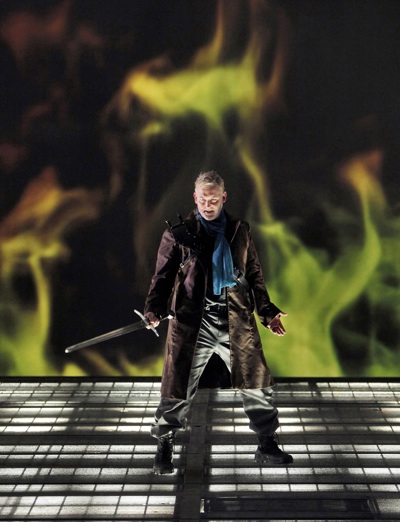
An American “Siegfried”
Our culture—that of American post-modernism—is less concerned with the strictures of tradition than with making ironic sense of the shifting complexities of a rapidly changing technological world … by whatever means possible.
And that makes Wagner’s Ring Cycle the perfect operatic event for us.
Wagner bent—in a manner similar to contemporary, and perhaps, finally, all artists—an ancient mythology to his own idiosyncratic philosophy on love and power. San Francisco Opera and Director Francesca Zambello’s Ring Cycle does much the same thing, and it’s a credit to their contemporary vision and artistic detailing that the production blends so seamlessly with Wagner’s own 19th-century artistic ideals. Honestly, how easy can it be to blend swords and trailer park dumps?
San Francisco Opera’s creative team have enlivened the opera by addressing current and crucial political issues, such as environmental despoliation and financial greed, powerfully but without falling into political cant.
Siegfried, the third in the Ring cycle, is perhaps the most difficult opera to stage. A series of long dialogs, it tends toward epic narrative as the characters endlessly explain events leading up to the current on-stage moment. The action is turgid and minimal. Even one of the plot highlights—Siegfried’s battle with the dragon Fafner—is shorter and, due to the difficulty of producing a fire-breathing monster, less dramatically convincing than the riddle scene between Wotan and Siegfried, which is simply a retelling of the opera’s complicated back story. The dragon in the current production, however, is not an overgrown, fiery lizard but a huge robotic scrap-metal compactor with grasping mechanical paws, driven by a giant in big boots with similarly bionic hands. This inventive interpretation encapsulates the overall intelligence and humor behind this production. San Francisco Opera does a bang-up job of presenting Siegfried, lightly slipping past its inherent dramatic problems.
Color with complex layers and restless motion is the secret behind the production’s success. Color of voice in the remarkable sounds flung into the stratosphere by Nina Stemme as Brünnehilde and Jay Hunter Morris as Siegfried. Wonderfully suited to each other, both singers have warm full overtones in their voices that support a bright, almost edgy, sound, and blend into a complex richness that is not sweet but powerful. Simply heroic. Morris played Siegfried as a charming and boyish prankster with deep underlying “issues” around his lost—and incestuous—parents, especially his dead mother. He gave the role an emotional range, moving from petulance to lustful energy, which is lacking in most mythic heroes. Stemme can unloose herself vocally more than Morris, her voice riding insistently vibrant and commanding over the lush intricacies of the orchestra. Simply, Stemme rocks!
Mark Delavan has grown into his role of Wotan. Listed as baritone, his voice has the deep resonance and authority of a bass. In the past few years he has added power to that voice.
Tenor David Gangelosi as Mime provided raucous comedy and showed an unoperatic athleticism, beyond his fine voice, with three cartwheels and a couple of somersaults.
Stacy Tappan was a lovely Forest Bird, capturing the vocal beauty of one of Wagner’s more gorgeous songs. And Ronnita Miller made a mythically resonant Erda.
Across these multiple vocal layers and interwoven with a thrilling orchestral interpretation led by Donald Runnicles, whose directing was subtle and just all around terrific, was the densely layered color of the production’s lighting and cinematic effects.
From the opening transformation of forest leaves into a clear-cut wasteland, followed by a forest of power lines, to the ending scene where green flames leap into a cloudy, ultramarine sky hovering over gray rocks splashed with patches of blood red, color seethed across both the stage and the cinematic landscape of the scrims. Liquid nitrogen and steam billowing in heavy clouds gave the images projected on the front scrim layers of motion and energy. Contrasting light colored the panoramic presentation of a world run amok through technological waste and desolation; the light filled in by projections at the back of the stage. It was as if Wagner’s many motifs had sprung to life in the eye as well as the ear, creating that magical beast that the composer sought throughout his career—a work of art that addressed to all the senses and fused into an intensely complete theatrical experience.
—Jaime Robles
Photo: Jay Hunter Morris as Siegfried. Photo by Cory Weaver
